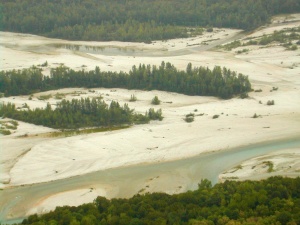Difference between revisions of "Role of vegetation"
| Line 12: | Line 12: | ||
<br /><br /> | <br /><br /> | ||
| − | Although there is still much to be learnt about the interactions between plants and hydromorphology, various [[:Category:Vegetation_Models|models]] are available in the scientific and technical literature for the interpretation of these interactions. Examples are models for evaluating the effect of vegetation on flow resistance, river bank dynamics, river bed development and river planform evolution. | + | Although there is still much to be learnt about the interactions between plants and hydromorphology, various [[:Category:Vegetation_Models|models]] are available in the scientific and technical literature for the interpretation of these interactions. Examples are [[:Category:Vegetation_Models|models]] for evaluating the effect of vegetation on flow resistance, river bank dynamics, river bed development and river planform evolution. |
<br /> | <br /> | ||
<br /> | <br /> | ||
| Line 18: | Line 18: | ||
* [http://www.reformrivers.eu/system/files/2.2%20Natural%20HyMo%20Biota%20Ecol%20Function%20part%201%20FINAL.pdf Gurnell A.M., González Del Tánago M., O’Hare M.T., Van Oorschot M., Belletti B., Buijse T., García De Jalón D., Grabowski R., Hendriks D., Mountford O., Rinaldi M., Solari L., Szewczyk M., Vargas-Luna A. (2014). Influence of Natural Hydromorphological Dynamics on Biota and Ecosystem Function. REFORM Deliverable 2.2 Part 1, Section 2.3]; | * [http://www.reformrivers.eu/system/files/2.2%20Natural%20HyMo%20Biota%20Ecol%20Function%20part%201%20FINAL.pdf Gurnell A.M., González Del Tánago M., O’Hare M.T., Van Oorschot M., Belletti B., Buijse T., García De Jalón D., Grabowski R., Hendriks D., Mountford O., Rinaldi M., Solari L., Szewczyk M., Vargas-Luna A. (2014). Influence of Natural Hydromorphological Dynamics on Biota and Ecosystem Function. REFORM Deliverable 2.2 Part 1, Section 2.3]; | ||
* [http://doi.org/DOI:10.1002/rra.2910 Solari L, Van Oorschot M, Belletti B, Hendriks D, Rinaldi M, and Vargas-Luna A. 2015. Advances on modelling riparian vegetation – hydromorphology interactions. River Research and applications. DOI:10.1002/rra.2910]; | * [http://doi.org/DOI:10.1002/rra.2910 Solari L, Van Oorschot M, Belletti B, Hendriks D, Rinaldi M, and Vargas-Luna A. 2015. Advances on modelling riparian vegetation – hydromorphology interactions. River Research and applications. DOI:10.1002/rra.2910]; | ||
| − | * [http://onlinelibrary.wiley.com/doi/10.1002/rra.2928/abstract Gurnell | + | * [http://onlinelibrary.wiley.com/doi/10.1002/rra.2928/abstract Gurnell et al (2015)] |
* [http://onlinelibrary.wiley.com/doi/10.1002/esp.3397/abstract Gurnell AM. 2014. Plants as river ecosystem engineers. Earth Surface Processes and Landforms 39(1): 4–25. DOI: 10.1002/esp.3397]; | * [http://onlinelibrary.wiley.com/doi/10.1002/esp.3397/abstract Gurnell AM. 2014. Plants as river ecosystem engineers. Earth Surface Processes and Landforms 39(1): 4–25. DOI: 10.1002/esp.3397]; | ||
Revision as of 14:19, 18 December 2018
Vegetation is a key element in rivers. Riparian vegetation (such as herbaceous plants, shrubs and trees) can be found on sediment deposits, on banks and along river margins (see the examples in Figure 1 and 2), while aquatic vegetation grows in or near water.
In river systems, vegetation interacts with hydromorphology in different ways:
- river hydromorphology plays a significant role in all plant life stages, from seed dispersal to colonization, recruitment, growth, succession and mortality. Successful riparian plants often adopt a combination of adaptive strategies during different life stages in order to ensure their survival. Examples are high dispersal rates, adaptations to resist stress, and vegetative reproduction;
- vegetation actively interacts with river hydromorphology. Above-ground plant biomass can affect the flow, by blocking it or changing flow resistance and sediment transport, for instance inducing sediment deposition. Below-ground plant biomass modifies the hydraulic and mechanical properties of the substrate, including the sediments retained by the above-ground biomass, and consequently the moisture regime and erodibility of the soil on the river bed and on banks.
Plants therefore can actively interact with river morphology by changing river bed topography, river planform shape and bed sediment composition, and by promoting the development of distinctive vegetated landforms.
Although there is still much to be learnt about the interactions between plants and hydromorphology, various models are available in the scientific and technical literature for the interpretation of these interactions. Examples are models for evaluating the effect of vegetation on flow resistance, river bank dynamics, river bed development and river planform evolution.
More details on the recent advances on modelling riparian vegetation - hydromorphology interactions can be found in:
- Gurnell A.M., González Del Tánago M., O’Hare M.T., Van Oorschot M., Belletti B., Buijse T., García De Jalón D., Grabowski R., Hendriks D., Mountford O., Rinaldi M., Solari L., Szewczyk M., Vargas-Luna A. (2014). Influence of Natural Hydromorphological Dynamics on Biota and Ecosystem Function. REFORM Deliverable 2.2 Part 1, Section 2.3;
- Solari L, Van Oorschot M, Belletti B, Hendriks D, Rinaldi M, and Vargas-Luna A. 2015. Advances on modelling riparian vegetation – hydromorphology interactions. River Research and applications. DOI:10.1002/rra.2910;
- Gurnell et al (2015)
- Gurnell AM. 2014. Plants as river ecosystem engineers. Earth Surface Processes and Landforms 39(1): 4–25. DOI: 10.1002/esp.3397;

